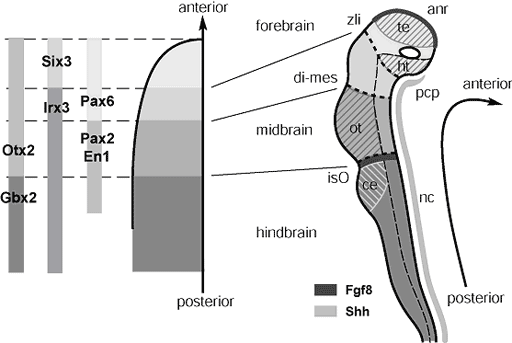

The generation of distinct classes of neurons which are allocated at the specific sites is a fundamental step during the brain development. Our laboratory has been studying the mechanisms underlying regional specification of the vertebrate forebrain. The embryonic brain that consists of a sheet of neuroepithelia is subdivided into many domains or compartments, which can be recognized by expression of a number of transcription factors and signaling molecules. The major issues here are how those molecularly distinct patterns are created, and the extent to which the regional complexity of the mature brain structures depends upon these early patterns. We are addressing these issues by means of molecular and cellular biology, experimental embryology, and genetics.

Fig. 1. Abbreviations
anr, anterior neural ridge; ce, cerebellum; di-mes, diencephalon-mesencephalon boundary; ht, hypothalamus; isO, isthmic organizer; nc, notochord; ot, optic tectum; pcp, prechordal plate; te, telencephalon; zli, zona limitans intrathalamica;
The central nervous system (CNS) arises from the neural plate, a cytologically homogeneous sheet of epithelial cells. The neuroepithelia, stem cells of the CNS, are thought to acquire distinct properties depending on the positions within the CNS primordium to yield enormously divergent neuronal cells at specific locations. In fact, the neural plate is subdivided into molecularly distinct domains with characteristic shapes and locations. We have found that 1) regionally restricted groups of cells that express particular signaling molecules, called signaling center, induce specific set of genes depending on the ranges and doses of signaling factors, 2) responses of the neuroepithelial cells to such signals are distinct according to the positions within the neural plate, which are defined by some sets of transcription factors, and 3) those relatively simple initial patterns created by the diffusible signals then transform into further complicated patterns in part by translocation of the defined cells. There are obviously more to find to gain a complete picture of the brain patterning. Important questions still remain, for instance, how those signaling centers are formed at the specific locations. While these early embryonic subdivisions represent histogenetic fields which generate neural structures such as brain nuclei, layers, fiber tracts, and neural circuits, the molecular and cellular mechanisms regulating this transformation are much less understood. The major scientific aim of our research is to achieve a better understanding of the relation between the early embryonic pattern formation and late histogenetic processes, including morphogenesis and functional differentiation of brain tissues. We will concentrate on the forebrain which holds pivotal brain structures, such as cerebral cortex, basal ganglia, thalamus, and hypothalamus. Current research subjects are:
Early pattern formation in the cephalic neural plate.
Regionalization of the embryonic telencephalon and its comparative developmental biology.
Cell type specification and morphogenetic processes involved in the formation of the nuclear structures.
Genetic fate mapping of the embryonic subdivisions in the neural plate and tube.
Cell lineage analysis to discover the neuroepithelial origins of particular neurons in the forebrain structures.
Cell biological studies on the neuroepithelial cells.